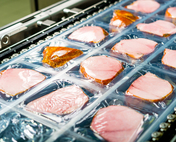|
Having trouble viewing this email? View it as a Web page.

|
|
|
Fresh from the Field is a weekly album showcasing transformative impacts made by partners supported by the National Institute of Food and Agriculture.
Editor: Falita Liles Feb.8, 2019
|
|
Success Stories

TSU Identifies Safer Shopping Practices
When discussing farm-to-fork food safety, it’s common to overlook consumer behavior in the store. Researchers at Tennessee State University report that over 60 percent of surfaces of meat packages are contaminated with meat juice, which transfers to shoppers' hands and grocery carts. While the researchers did not specifically test for the presence of human pathogens in these juices, other studies report high prevalence of the human pathogens Campylobacter and Salmonella in raw meat juices. This study reports that using secondary plastic bags to handle poultry packages at the store essentially eliminates the risk of cross-contamination during shopping, and this practice is significantly more effective than using secondary plastic bags at the check-out. Researchers also warn that re-packing at home exposes home kitchens to contamination. For a safer shopping experience, always use a secondary plastic bag to handle poultry containers in the store, do not re-pack poultry at home, keep meat frozen or refrigerated until immediately prior to use, and do not re-use plastic bags that contained poultry.
NIFA supports this research through the Agricultural Food and Research Initiative.
Read more about this project through NIFA's Data Gateway.
|
News Coverage

Students Engaging the Environment: A Student/Scientist Collaboration to Assess Aquatic Invasive Species
Invasive fish species pose a significant threat to aquaculture, fisheries, the sport fishing industry, water resources, and the environment.
Researchers at Cornell University have developed an efficient citizen science-based mechanism for widespread early detection and monitoring of invasive fish. Water samples collected by student citizen scientists across the state are analyzed for environmental DNA (eDNA) from several invasive fish species. eDNA samples are analyzed at Cornell University and results are displayed on interactive Google maps on the internet. A summary of the eDNA analysis and test results are returned to the classroom to facilitate learning and further discussion of invasive fish related issues.
In this pilot program, 100 teachers and over 2,500 students at 87 schools have successfully used project kits to collect eDNA as part of an expandable collaborative model that allows economical statewide monitoring of invasive fish. Curriculum has been designed around kit use to increase student interest in and understanding of the impacts of invasive species on native biodiversity and ecosystem function. It also addresses the resultant impacts on economically important industries like aquaculture, freshwater fisheries, sport fishing, and tourism. Hands-on involvement in monitoring local waters highlights the need for prevention to limit the spread of invasive fish. As part of this new program, 253 sites across NY have been tested for eDNA to determine the presence of invasive round goby, four species of Asian carp, and sea lamprey. Preliminary tests for the presence of snakehead fish have also been successfully carried out. All data is displayed on interactive maps on the Fishtracker program website providing a valuable resource that will aid in the development of a broad invasive fish management strategy.
NIFA supports this research through the Hatch Act.
Read more about this project through NIFA's Data Gateway.
|
Library

Farms to Food Banks in Kentucky
In 2017, The Kentucky Association of Food Banks received a $400,000 Community Food Projects grant for the Farms To Food Banks Capacity Building project. The project will increase access to nutritious food among food-insecure Kentuckians and strengthen the linkages between key sectors of Kentucky's food system, including farmers, nonprofit food distributors and low-income consumers.
The project will increase the capacity of Kentucky’s emergency food distribution system to distribute fresh produce. To accomplish this objective, a Western Star 5700 XE tractor truck was placed with God’s Pantry Food Bank in Lexington, Kentucky the spring of 2018.
During the first four months of full service, the equipment dramatically improved the food bank’s fresh produce handling capacity in Southeastern Kentucky. Specifically, produce volumes increased more than 37 percent versus the same period last year.
Food pantries in the following counties received fresh produce as a result: Bell, Clay, Harlan, Jackson, Knox, Laurel, Leslie, McCreary, Owsley, Pulaski, Rockcastle, and Whitley.
Many of the local charitable feeding organizations in Kentucky’s food bank network lack the cold storage capacity necessary to store perishable items for distribution to low-income consumers. The increased capacity allowed God’s Pantry Food Bank to expand its distribution capabilities and deliver the highly perishable product to partner agencies using a “just in time” model that required minimal cold storage capacity on the part of agencies. The increased capacity also allowed God’s Pantry Food Bank to distribute the produce directly to consumers in communities without a partner agency able to distribute fresh produce. Kentucky’s charitable food distribution network now possesses enhanced physical infrastructure and increased capacity to safely distribute perishable fresh produce.
Read more about this project through NIFA's Data Gateway.
NIFA supports this work through a Community Foods Project grant.
|
Tweet of the Week
#NIFAIMPACTS

|
|

NIFA’s mission is to invest in and advance agricultural research, education, and extension that solve societal challenges. NIFA’s investments in transformative science directly support the long-term prosperity and global preeminence of U.S. agriculture. To learn more about NIFA’s impact on agricultural sciences, visit www.nifa.usda.gov/Impacts, sign up for email updates or follow us on Twitter @USDA_NIFA, #NIFAImpacts.
USDA is an equal opportunity lender, provider, and employer.
|
|